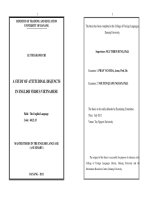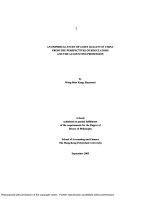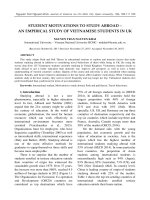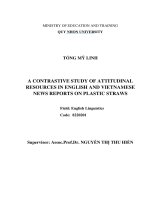An appraisal study of attitudinal resources in online newspaper commentaries on the world cup 2022
Bạn đang xem bản rút gọn của tài liệu. Xem và tải ngay bản đầy đủ của tài liệu tại đây (1.53 MB, 75 trang )
MINISTRY OF EDUCATION AND TRAINING
QUY NHON UNIVERSITY
HUỲNH THANH HOÀNG OANH
AN APPRAISAL STUDY OF
ATTITUDINAL RESOURCES IN
ONLINE NEWSPAPER COMMENTARIES
ON THE WORLD CUP 2022
Field: English Linguistics
Code: 8220201
Supervisor: Assoc.Prof.Dr. NGUYỄN THỊ THU HIỀN
BỘ GIÁO DỤC VÀ ĐÀO TẠO
TRƯỜNG ĐẠI HỌC QUY NHƠN
HUỲNH THANH HOÀNG OANH
NGHIÊN CỨU NGHĨA THÁI ĐỘ
TRONG BÌNH LUẬN TRÊN BÁO TRỰC TUYẾN
VỀ WORLD CUP 2022
Chuyên ngành : Ngôn ngữ Anh
Mã số : 8220201
Người hướng dẫn: PGS. TS. NGUYỄN THỊ THU HIỀN
i
STATEMENT OF AUTHORSHIP
I certify that this thesis An Appraisal Study of Attitudinal Resources in
Online Newspaper Commentaries on the World Cup 2022 contains no material
extracted or published elsewhere except where reference is made in the study.
This thesis has not been submitted for any degree and is not currently
being submitted for any other degree or award.
Binh Dinh, 2023
Huynh Thanh Hoang Oanh
ii
ACKNOWLEDGEMENTS
I am grateful to many individuals who have heartened me in various
ways to achieve my accomplishment today.
I would like to express my deep and sincere gratitude to my research
supervisor, Assoc. Prof. Dr. Nguyen Thi Thu Hien for giving me the
opportunity to do research and providing invaluable guidance throughout this
thesis. Without her timely enlightenment, my M.A. journey could have been
interrupted. Her dynamism, vision, dedication and motivation have deeply
inspired me. She has taught me the methodology to carry out the research and
present the research as clearly as possible. It is really a great privilege and honor
to work and study under her guidance.
Additionally, I gratefully acknowledge my indebtedness to all of my
lecturers who play a significant role in nurturing my interest in linguistic
research. They have provided me with interesting and useful lectures and
created favorable conditions for me to enhance my skills and widen my horizon
of the knowledge of Linguistics for the past two years.
Next, my sincere thanks go to all of my classmates, M.A students of
English course 24th at Quy Nhon University, who supported me during the time
we took the course together.
Last but absolutely not least, from the bottom of my heart, I owe my debt
to my family for their unconditional love and tremendous encouragement.
Without their supports, I could not have overcome all the challenges and
obstacles on my academic pathway.
iii
ABSTRACT
The thesis applied Appraisal Theory to analyze Attitudinal resources
in English online newspaper commentaries on the World Cup 2022. The study
aims at realizing the Attitudinal resources namely Affect, Judgement, and
Appreciation and identifying the frequency of occurrence of subtypes used in
online newspaper commentaries. The data is composed of 20 commentaries in
English and collected from reliable online websites. The research findings
indicated that Appreciation and Judgement resources are strongly favored by
EONCs writers. The authors tend to focus on evaluating the different events
and people’s behaviours during the World Cup 2022 rather than express the
emotions or feelings. EONCs writers are inclined to apply more Positive Affect,
Positive Judgement, Positive Appreciation than Negative ones to convey their
own emotions about the feelings of football, highlight the qualities and talents
of the players, and express love for football. Explicit Judgement and Explicit
Appreciation are superior to Implicit ones to help the language of evaluation
clearer and make phenomena/objects become more animate. The research
outcomes are expected to be of valuable reference for learners of English in
writing commentaries.
iv
ABBREVIATIONS AND CONVENTIONS
ABBREVIATIONS
Aff : Affect
App : Appreciation
Auth : Authorial
Cap : Judgement: Capacity
Comp : Appreciation: Composition
EONCs : English Online Newspaper Commentaries
Exp : Explicit
Hap : Affect: Un/Happiness
Imp : Implicit
Inc : Affect: Dis/Inclination
Judg : Judgement
Non-Auth : Non-Authorial
Nor : Judgement: Normality
Prop : Judgement: Propriety
Reac : Appreciation: Reaction
Sat : Affect: Dis/Satisfaction
Sec : Affect: In/Security
Ten : Judgement: Tenacity
Val : Appreciation: Valuation
Ver : Judgement: Veracity
(-) : Negative
(+) : Positive
v
CONVENTIONS
Italics are used for quotes, technical terms, emphasis, and examples
Bold is deployed to mark the first use of technical terms
In the numbered examples: Bold marks the use of what is being
demonstrated.
vi
TABLE OF CONTENTS
STATEMENT OF AUTHORSHIP .............................................................. i
ACKNOWLEDGEMENTS ......................................................................... ii
ABSTRACT................................................................................................. iii
ABBREVIATIONS AND CONVENTIONS .............................................. iv
TABLE OF CONTENTS ............................................................................ vi
LIST OF TABLES ...................................................................................... ix
LIST OF FIGURES ..................................................................................... x
CHAPTER 1: INTRODUCTION................................................................ 1
1.1. Rationale .............................................................................................. 1
1.2. Aim and objectives ............................................................................... 3
1.2.1. Aim of the study .............................................................................. 3
1.2.2. Objectives of the study.................................................................... 3
1.3. Research questions ............................................................................... 3
1.4. Scope of the study ................................................................................ 3
1.5. Significance of the study ...................................................................... 4
1.6. Organization of the study ..................................................................... 4
CHAPTER 2: LITERATURE REVIEW .................................................... 6
2.1. Appraisal Theory.................................................................................. 6
2.1.1. An overview of Appraisal Theory ................................................... 6
2.1.2. Appraisal Resources....................................................................... 8
2.1.2.1. Engagement .............................................................................. 8
2.1.2.2. Graduation ............................................................................. 10
2.1.2.3. Attitude ................................................................................... 10
2.1.3. Attitude Resources ........................................................................ 11
vii
2.1.3.1. Affect ................................................................................... 12
2.1.3.2. Judgement ........................................................................... 14
2.1.3.3. Appreciation ......................................................................... 17
2.2. Application of Appraisal Theory in discourse analysis ....................... 20
CHAPTER 3: RESEARCH METHODOLOGY ...................................... 24
3.1. Research Design ................................................................................. 24
3.2. Data Collection................................................................................... 24
3.3. Data Analysis ..................................................................................... 27
3.4. Research procedures ........................................................................... 27
3.5. Reliability and validity in the research................................................ 27
CHAPTER 4: FINDINGS AND DISCUSSIONS ..................................... 28
4.1. The overall usage of the Attitude resources in EONCs ....................... 28
4.2. Affect resources in EONCs ................................................................ 30
4.2.1. Sub-types of Affect resources in EONCs ....................................... 30
4.2.2. Positive and Negative Affect resources in EONCs ........................ 35
4.2.3. Authorial and Non-Authorial Affect resources in EONCs............. 37
4.3. Judgement resources in EONCs ......................................................... 39
4.3.1. Social Esteem and Social Sanction ............................................... 39
4.3.2. Positive and Negative Judgment resources in EONCs .................. 44
4.3.3. Explicit and Implicit Judgment resources in EONCs .................... 46
4.4. Appreciation resources in EONCs ...................................................... 48
4.4.1. Sub-types of Appreciation resources in EONCs............................ 48
4.4.2. Positive and Negative Appreciation resources in EONCs............. 51
4.4.3. Explicit and Implicit Appreciation resources in EONCs............... 53
CHAPTER 5: CONCLUSIONS AND IMPLICATIONS ........................ 57
5.1. Summary of the findings .................................................................... 57
5.2. Implications........................................................................................ 59
viii
5.3. Limitations of the study ...................................................................... 59
5.4. Suggestions for further research ......................................................... 60
REFERENCES........................................................................................... 61
ix
LIST OF TABLES
Table 2. 1. The Monogloss and the Heterogloss.......................................................9
Table 2. 2. Grammatical realizations of Affect ...................................................... 16
Table 2. 3. The system of Judgement ..................................................................... 18
Table 2. 4. Categories of Appreciation................................................................... 18
Table 4. 1. Attitude sub-types in EONCs ............................................................... 28
Table 4. 2. Authorial and Non-Authorial Affect resources in EONCs .................... 37
Table 4. 3. Sub-types of Judgement resources in EONCs....................................... 41
Table 4. 4. Explicit and Implicit Judgement resources in EONCs .......................... 46
Table 4. 5. Explicit and Implicit Appreciation resources in EONCs....................... 53
x
LIST OF FIGURES
Figure 2. 1. An overview of Appraisal resources .....................................................8
Figure 2. 2. Sub-systems of Attitude...................................................................... 12
Figure 4. 1. Sub-types of Affect resources in EONCs ............................................ 31
Figure 4. 2. Frequency occurrence of parts of speeches in Affect resources in
EONCs ………………………………………………………………………….…33
Figure 4. 3. Positive and Negative Affect resources in EONCs.............................. 35
Figure 4. 4. Social Esteem and Social Sanction in EONCs .................................... 40
Figure 4. 5. Positive and Negative Judgement resources in EONCs ....................... 44
Figure 4. 6. Sub-types of Appreciation resources in EONCs.................................. 49
Figure 4. 7. Positive and Negative Appreciation resources in EONCs ................... 51
1
CHAPTER 1
INTRODUCTION
The researcher begins this chapter by presenting all of the thesis'
preliminary materials. It begins with the rationale, then moves on to the study's
purpose and objectives, research questions, significance, and scope. The study's
organization is presented in the last section of the research.
1.1. Rationale
Languages are tools to communicate, in a sense, means to convey
thoughts, ideas, concepts, or even a feeling via numerous talks, videos, news,
and commentaries which have been carried out to provide information about
every aspect of life. World Cup 2022 is considered the most popular sporting
event in the world, which attracts billions of people. As a result, there are news
articles about the problems happening on the sidelines of the biggest
tournament on the planet. However, online newspaper commentaries are
considered an effective tool for reflecting on the issues of this tournament as
well as being one of the most popular approaches for those who want to update
large amounts of the World Cup’s information. Indeed, the success of any
online commentary depends not only on how influential the issues are but on
how well the reporters themselves know how to communicate their findings to
the audience. Among them, CNN, Fox Sports, and Reuters are considered as
reliable information channels to reflect as well as express different views on
the impact of this sporting event.
There is no denying that the framework of Appraisal Theory, which was
conducted by a group of scholars led by two linguists, namely James Martin
and Peter White in the 1980s and 1990s, is considered the theory
in psychology that emotions are extracted from our evaluations (appraisals or
2
estimates) of events that cause specific reactions in different people.
Essentially, our appraisal of a situation causes an emotional or affective,
response that is going to be based on that appraisal. Appraisal framework,
according to Martin and White (2005), is a specific approach to exploring,
describing, and explaining how language is used to evaluate, adopt stances,
construct textual personas, and manage interpersonal positioning and
relationships. Therefore, Appraisal framework is seen as an effective tool for
analyzing attitude expressions and interpersonal meanings in various types of
discourse such as literary works, advertisements, talks, news, academic and
narrative discourse.
There have been some studies carried out, using the Appraisal Theory as
a theoretical framework. Mohammed (2016) focuses on exploring the
Appraisal election defeat concession the presidents’ speeches. Hood (2004) and
Liu (2010) try to apply Appraisal Theory into teaching process in an attempt to
get better results for students of English. Vo Duy Duc (2011) studies
journalistic voices operating in English Vietnamese hard news reports in the
light of Appraisal Theory. Nguyen Thi Thu Hien (2016) carries out researching
the social attitudes in news reports towards President Obama’s visit to Vietnam.
As a result, it can be found that Appraisal Theory has been applied in a wide
variety of genres, which proves its significance as a theoretical framework to
help understand the evaluative language. However, it seems that no prior
research has been done on the study of attitudinal resources in online newspaper
commentaries on a global sporting event like World Cup, which means there is
a gap available for my thesis.
It is for these reasons that I am inspired and motivated to conduct a study
on the attitudinal aspects of online newspaper commentaries about the World
3
Cup 2022 with the topic: “An Appraisal Study of Attitudinal Resources in
Online Newspaper Commentaries on the World Cup 2022”.
1.2. Aim and objectives
1.2.1. Aim of the study
The aim of the study is to investigate Attitudinal Resources used in online
newspaper commentaries on the World Cup 2022 from the perspective of
Appraisal Theory to find out the way English authors show their attitudes on
such issues.
1.2.2. Objectives of the study
For the aforementioned aim to be fulfilled, the research concentrated on
the following objectives:
- To realize Attitudinal Resources used in online newspaper
commentaries on the World Cup 2022;
- To identify the frequency of occurrence of subtypes of Attitudinal
Resources used in online newspaper commentaries on the World Cup 2022.
1.3. Research questions
Based on the aim of the study, the following research questions are
expected to be answered:
1. What Attitudinal Resources are realized in online newspaper
commentaries on the World Cup 2022?
2. How often are the subtypes of Attitudinal Resources used in online
newspaper commentaries on the World Cup 2022?
1.4. Scope of the study
Though the Appraisal Theory is composed of three domains, precisely
Attitude, Engagement and Graduation, this study focuses on the Attitudinal
resources, namely Affect, Judgement, and Appreciation due to their
considerable significance in revealing attitudes meeting the aim of the study.
4
To reach the aim, 20 online newspaper commentaries will be gathered
from the websites /> These commentaries are all collected from the
reliable resources from November 2022 to December 2022 - the period that The
World Cup 2022 became a topical issue and attract on people all around the
world, especially fans of football.
1.5. Significance of the study
This study is expected to contribute to the research, performance, and
interpretation of attitudinal values from theoretical as well as practical
perspectives.
Moreover, this study may be a new approach to gaining insight into the
features of attitudinal values conveyed by online newspaper commentaries on
the World Cup 2022. Additionally, it is supposed to provide a reliable reference
for readers who are interested in attitudinal values so that they are likely to have
a thorough grasp of the evaluative language.
1.6. Organization of the study
This study consists of five main chapters, as follows:
Chapter 1, Introduction, introduces the rationale, the aim and objectives
of the study, research questions, the scope of the study, the significance of the
study and organization of the study.
Chapter 2, Literature Review, presents Appraisal Theory including a
brief description of its sub-systems consisting of Attitude, Engagement, and
Graduation, with attention being paid to the Attitudinal aspects. Then, a concise
review of the previous studies related to the issues under investigation is also
presented.
Chapter 3, Research Methodology, discusses research methods of
research, comprising data collection, data analysis, the reliability and validity
5
of the research.
Chapter 4, Findings and Discussion deals with the analysis and the
findings of the study. The study analyzes and discusses Attitudinal resources
and the frequency of their occurrence in online newspaper commentaries on the
World Cup 2022.
Chapter 5, Conclusions and Implications, gives out a concise summary
of the research findings, suggests implications for teaching and learning
English, and mentions the shortcomings of the research. Additionally,
suggestions for further studies are also put forward in this chapter.
In summary, this chapter serves as the thesis's preliminary material. It
begins with the rationale, then moves on to the study's aim and objectives,
research questions, scope of the study, significance of the study, and
organization. In other words, Chapter 1 aims to provide an overview of the
contents of the subsequent chapters, thereby contributing to the development
of the research outline.
6
CHAPTER 2
LITERATURE REVIEW
This chapter provides a high-level overview of the fundamental
dimensions that serve as the study's theoretical framework. This section of the
study focuses on Attitudinal resources as an Appraisal Theory system. This
section also discusses previous studies that are pertinent to the current research.
2.1. Appraisal Theory
2.1.1. An Overview of Appraisal Theory
In the 1900s, a group of researchers led by Professor James Martin of the
Linguistics Department at the University of Sydney proposed Appraisal Theory
(Ruo-mei, 2016).
According to Martin and Rose (2003), Appraisal is a system of
interpersonal meanings. We use Appraisal resources to negotiate social
relationships by telling our listeners or readers how we feel about things and
people.
Martin & White (2005) claim that Appraisal is recognized as a specific
approach to evaluating language, adopting stances, constructing textual
characters, and constituting interpersonal positioning and relationships. It
investigates how speakers/writers pass on their attitudes, judgements, or
opinions to listeners/readers in order to form alliances with those who share
their experience and point of view and distance themselves from those who do
not.
Appraisal, as determined by Martin (2000), also investigates how
attitudes, judgements, and emotional responses from speakers/writers are
explicitly presented or expressed implicitly in texts. Appraisal is used to
analyze discourse resources in order to negotiate social relationships by telling
listeners/readers how they feel about specific people or things.
7
Appraisal Theory, the evaluative use of language provides a framework
for evaluating people, things, events, places, or processes. Its primary function
is to help “writers/speakers positively or negatively evaluate the entities,
happenings and states-of-affairs with which their texts are concerned” (Martin
& White, 2005, p. 2).
Furthermore, Martin and Rose (2004) stated that the resources of
Appraisal are used to organize our social relationships by informing our
listeners or readers of our feelings about things and people; in other words, our
attitudes.
As for the language level where Appraisal can be applied to understand
the language of education, Appraisal Theory is a developing theory within
discourse analysis and conversation analysis, according to Richards and
Schmidt (2010, p. 30). It is concerned with the ways in which attitudes such as
certainty, emotional response, social evaluation, and intensity are expressed.
Appraisal can be performed on lexical items or on entire clauses.
In brief, it can be seen that Appraisal is used as an umbrella term to refer
to the semantic resources, such as words, phrases, and structures, that speakers
or writers use to negotiate emotions, Judgements, and valuations. From a
semantic standpoint, Appraisal Theory is made up of three interacting domains:
Attitude, Engagement, and Graduation. Attitude takes center stage. It is
concerned with our emotions, including emotional reactions, behavioral
Judgements, and the evaluation of things. Engagement is concerned with
sourcing attitudes and the play of voices around opinions. Graduation
addresses the phenomenon of grading, in which feelings are amplified and
categories are blurred. These three systems can be subdivided further.
Attitudes can be classified into three types of feelings: Affect,
Judgement, and Appreciation. Monoglossia and Heteroglossia are involved
8
in the Engagement. Graduation has two subsystems as well. They are called
Force and Focus. Figure 2.1 depicts an overview of these appraisal systems.
APPRAISAL ENGAGEMENT MONOGLOSS
ATTITUDE HETEROGLOSS
GRADUATION raise
AFFECT lower
JUDGEMENT sharpen
APPRECIATION soften
FORCE
FOCUS
Figure 2.1. An overview of Appraisal resources
(Source: Martin & White, 2005, p. 38)
2.1.2. Appraisal Resources
2.1.2.1. Engagement
According to Martin & White (2005), Engagement is concerned with the
linguistic resources that enable speakers/writers to take a position toward the
value positions referenced by the text as well as those they address.
Engagement is composed of two sub-types, namely Monogloss and









